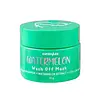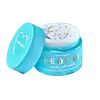What's inside
What's inside
 Key Ingredients
Key Ingredients

 Benefits
Benefits

 Concerns
Concerns

 Ingredients Side-by-side
Ingredients Side-by-side

Niacinamide
SmoothingPropylene Glycol
HumectantHydroxypropyl Methylcellulose
Emulsion StabilisingSodium PCA
HumectantCitrullus Lanatus Fruit Extract
Skin ConditioningAloe Barbadensis Leaf Extract
EmollientCollagen
MoisturisingDMDM Hydantoin
PreservativeSodium Hyaluronate
HumectantAllantoin
Skin ConditioningGellan Gum
Actinidia Chinensis Seed Extract
Skin ConditioningPhenoxyethanol
PreservativeParfum
MaskingPentylene Glycol
Skin ConditioningMethyl Diisopropyl Propionamide
MaskingCI 14720
Cosmetic ColorantCI 47005
Cosmetic ColorantNiacinamide, Propylene Glycol, Hydroxypropyl Methylcellulose, Sodium PCA, Citrullus Lanatus Fruit Extract, Aloe Barbadensis Leaf Extract, Collagen, DMDM Hydantoin, Sodium Hyaluronate, Allantoin, Gellan Gum, Actinidia Chinensis Seed Extract, Phenoxyethanol, Parfum, Pentylene Glycol, Methyl Diisopropyl Propionamide, CI 14720, CI 47005
Cyclopentasiloxane
EmollientGlycerin
HumectantCetyl Alcohol
EmollientGlyceryl Stearate
EmollientPEG-100 Stearate
Isododecane
EmollientCentella Asiatica Extract
CleansingMelaleuca Alternifolia Leaf Extract
PerfumingKaolin
AbrasiveParfum
MaskingPhenoxyethanol
PreservativeLaureth-7
EmulsifyingCucumis Sativus Fruit Extract
EmollientPolyacrylamide
C13-14 Isoparaffin
EmollientHypnea Musciformis Extract
Skin ProtectingGelidiella Acerosa Extract
Skin ProtectingAloe Barbadensis Leaf Extract
EmollientHyaluronic Acid
HumectantSodium PCA
HumectantGlycine
BufferingFructose
HumectantNiacinamide
SmoothingSodium Lactate
BufferingUrea
BufferingAllantoin
Skin ConditioningBHT
AntioxidantTitanium Dioxide
Cosmetic ColorantCellulose
AbsorbentMannitol
HumectantCI 77289
Cosmetic ColorantTocopheryl Acetate
AntioxidantHydroxypropyl Methylcellulose
Emulsion StabilisingCI 12490
Cosmetic ColorantCI 77492
Cosmetic ColorantCI 77491
Cosmetic ColorantPentylene Glycol
Skin ConditioningMethyl Diisopropyl Propionamide
MaskingCyclopentasiloxane, Glycerin, Cetyl Alcohol, Glyceryl Stearate, PEG-100 Stearate, Isododecane, Centella Asiatica Extract, Melaleuca Alternifolia Leaf Extract, Kaolin, Parfum, Phenoxyethanol, Laureth-7, Cucumis Sativus Fruit Extract, Polyacrylamide, C13-14 Isoparaffin, Hypnea Musciformis Extract, Gelidiella Acerosa Extract, Aloe Barbadensis Leaf Extract, Hyaluronic Acid, Sodium PCA, Glycine, Fructose, Niacinamide, Sodium Lactate, Urea, Allantoin, BHT, Titanium Dioxide, Cellulose, Mannitol, CI 77289, Tocopheryl Acetate, Hydroxypropyl Methylcellulose, CI 12490, CI 77492, CI 77491, Pentylene Glycol, Methyl Diisopropyl Propionamide
Ingredients Explained
These ingredients are found in both products.
Ingredients higher up in an ingredient list are typically present in a larger amount.
Allantoin is a soothing ingredient known for its protective and moisturizingg properties. Because of this, it is often added to products with strong active ingredients.
Studies show higher concentrations of this ingredient can promote wound healing.
Though it can be derived from the comfrey plant, allantoin is produced synthetically for cosmetic products to ensure purity.
Learn more about AllantoinAloe Barbadensis Leaf Extract is an extract of the leaves of the aloe, Aloe barbadensis, Liliaceae.
Aloe is one of the most well-known natural soothing ingredients, and for good reason. It’s full of water and has a cooling, calming effect on the skin, especially when it’s sunburned, itchy, or irritated. Aloe also helps your skin stay hydrated and smooth by mimicking what healthy skin naturally produces. On top of that, it contains vitamins and nutrients that support skin recovery.
It doesn’t protect you from the sun, but it can help your skin bounce back after too much time in it.
Let’s get into the details:
Aloe contains antioxidant Vitamins A, C, and E, which help fight off free radicals (unstable molecules from things like pollution that can damage your skin).
It’s also rich in polysaccharides, which are natural sugars that help hydrate the skin by acting like the skin’s own moisturizing agents. These, along with other sugars like monosaccharides, help form a protective barrier that locks in moisture.
Aloe works as both a humectant and an emollient. That means it draws water into the skin (humectant) and helps trap it there (emollient), making it an effective natural moisturizer.
You’ll also find a mix of other skin-supporting ingredients in aloe, including folic acid, choline, calcium, amino acids, fatty acids, and even Vitamin B12.
Out of the 420+ species of aloe, Aloe barbadensis is the most widely used in skincare products thanks to its gentle yet effective properties.
There are over 420 species of aloe but Aloe Barbadensis is the most commonly used for topical products.
Learn more about Aloe Barbadensis Leaf ExtractThis ingredient is a semi-synthetic polymer created from cellulose. In case you need a refresher, cellulose is the main component of plant cell walls.
Hydroxypropyl Methylcellulose has many uses:
- emulsifier
- create a gel-like texture
- boost foam
We don't have a description for Methyl Diisopropyl Propionamide yet.
Niacinamide is a multitasking form of vitamin B3 that strengthens the skin barrier, reduces pores and dark spots, regulates oil, and improves signs of aging.
And the best part? It's gentle and well-tolerated by most skin types, including sensitive and reactive skin.
You might have heard of "niacin flush", or the reddening of skin that causes itchiness. Niacinamide has not been found to cause this.
In very rare cases, some individuals may not be able to tolerate niacinamide at all or experience an allergic reaction to it.
If you are experiencing flaking, irritation, and dryness with this ingredient, be sure to double check all your products as this ingredient can be found in all categories of skincare.
When incorporating niacinamide into your routine, look out for concentration amounts. Typically, 5% niacinamide provides benefits such as fading dark spots. However, if you have sensitive skin, it is better to begin with a smaller concentration.
When you apply niacinamide to your skin, your body converts it into nicotinamide adenine dinucleotide (NAD). NAD is an essential coenzyme that is already found in your cells as "fuel" and powers countless biological processes.
In your skin, NAD helps repair cell damage, produce new healthy cells, support collagen production, strengthen the skin barrier, and fight environmental stressors (like UV and pollution).
Our natural NAD levels start to decline with age, leading to slower skin repair, visible aging, and a weaker skin barrier. By providing your skin niacinamide, you're recharging your skin's NAD levels. This leads to stronger, healthier, and younger looking skin.
Another name for vitamin B3 is nicotinamide. This vitamin is water-soluble and our bodies don't store it. We obtain Vitamin B3 from either food or skincare. Meat, fish, wheat, yeast, and leafy greens contain vitamin B3.
The type of niacinamide used in skincare is synthetically created.
Learn more about NiacinamideParfum is a catch-all term for an ingredient or more that is used to give a scent to products.
Also called "fragrance", this ingredient can be a blend of hundreds of chemicals or plant oils. This means every product with "fragrance" or "parfum" in the ingredients list is a different mixture.
For instance, Habanolide is a proprietary trade name for a specific aroma chemical. When used as a fragrance ingredient in cosmetics, most aroma chemicals fall under the broad labeling category of “FRAGRANCE” or “PARFUM” according to EU and US regulations.
The term 'parfum' or 'fragrance' is not regulated in many countries. In many cases, it is up to the brand to define this term.
For instance, many brands choose to label themselves as "fragrance-free" because they are not using synthetic fragrances. However, their products may still contain ingredients such as essential oils that are considered a fragrance by INCI standards.
One example is Calendula flower extract. Calendula is an essential oil that still imparts a scent or 'fragrance'.
Depending on the blend, the ingredients in the mixture can cause allergies and sensitivities on the skin. Some ingredients that are known EU allergens include linalool and citronellol.
Parfum can also be used to mask or cover an unpleasant scent.
The bottom line is: not all fragrances/parfum/ingredients are created equally. If you are worried about fragrances, we recommend taking a closer look at an ingredient. And of course, we always recommend speaking with a professional.
Learn more about ParfumPentylene glycol is typically used within a product to thicken it. It also adds a smooth, soft, and moisturizing feel to the product. It is naturally found in plants such as sugar beets.
The hydrophilic trait of Pentylene Glycol makes it a humectant. As a humectant, Pentylene Glycol helps draw moisture from the air to your skin. This can help keep your skin hydrated.
This property also makes Pentylene Glycol a great texture enhancer. It can also help thicken or stabilize a product.
Pentylene Glycol also acts as a mild preservative and helps to keep a product microbe-free.
Some people may experience mild eye and skin irritation from Pentylene Glycol. We always recommend speaking with a professional about using this ingredient in your routine.
Pentylene Glycol has a low molecular weight and is part of the 1,2-glycol family.
Learn more about Pentylene GlycolPhenoxyethanol is a preservative that has germicide, antimicrobial, and aromatic properties. Studies show that phenoxyethanol can prevent microbial growth. By itself, it has a scent that is similar to that of a rose.
It's often used in formulations along with Caprylyl Glycol to preserve the shelf life of products.
Sodium PCA is the sodium salt of pyroglutamic acid. It is naturally occurring in our skin's natural moisturizing factors where it works to maintain hydration.
The PCA stands for pyrrolidone carboxylic acid, a natural amino acid derivative.
This ingredient has skin conditioning, anti-inflammatory, and humectant properties. Humectants help hydrate your skin by drawing moisture from the air. This helps keep your skin moisturized.
Learn more about Sodium PCA